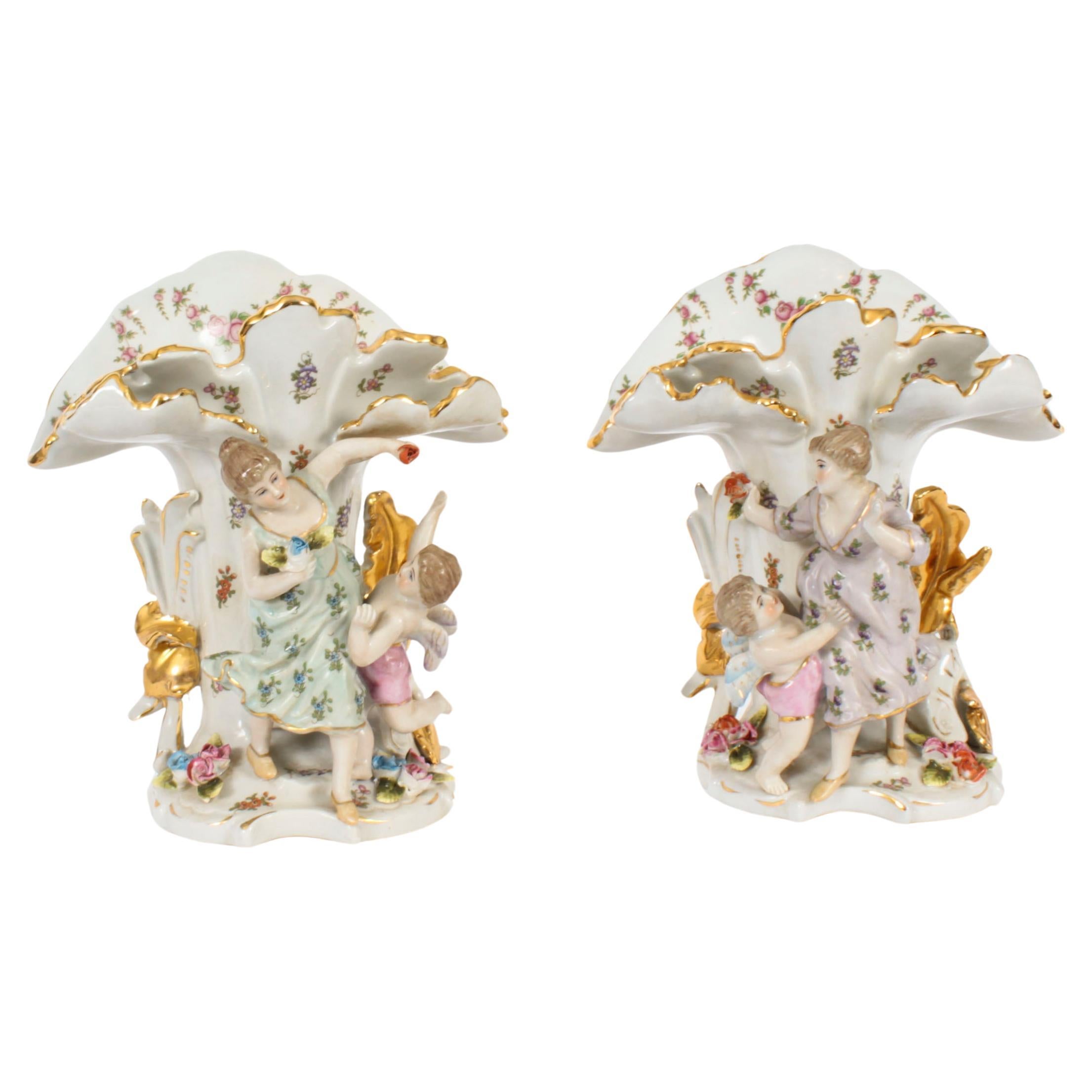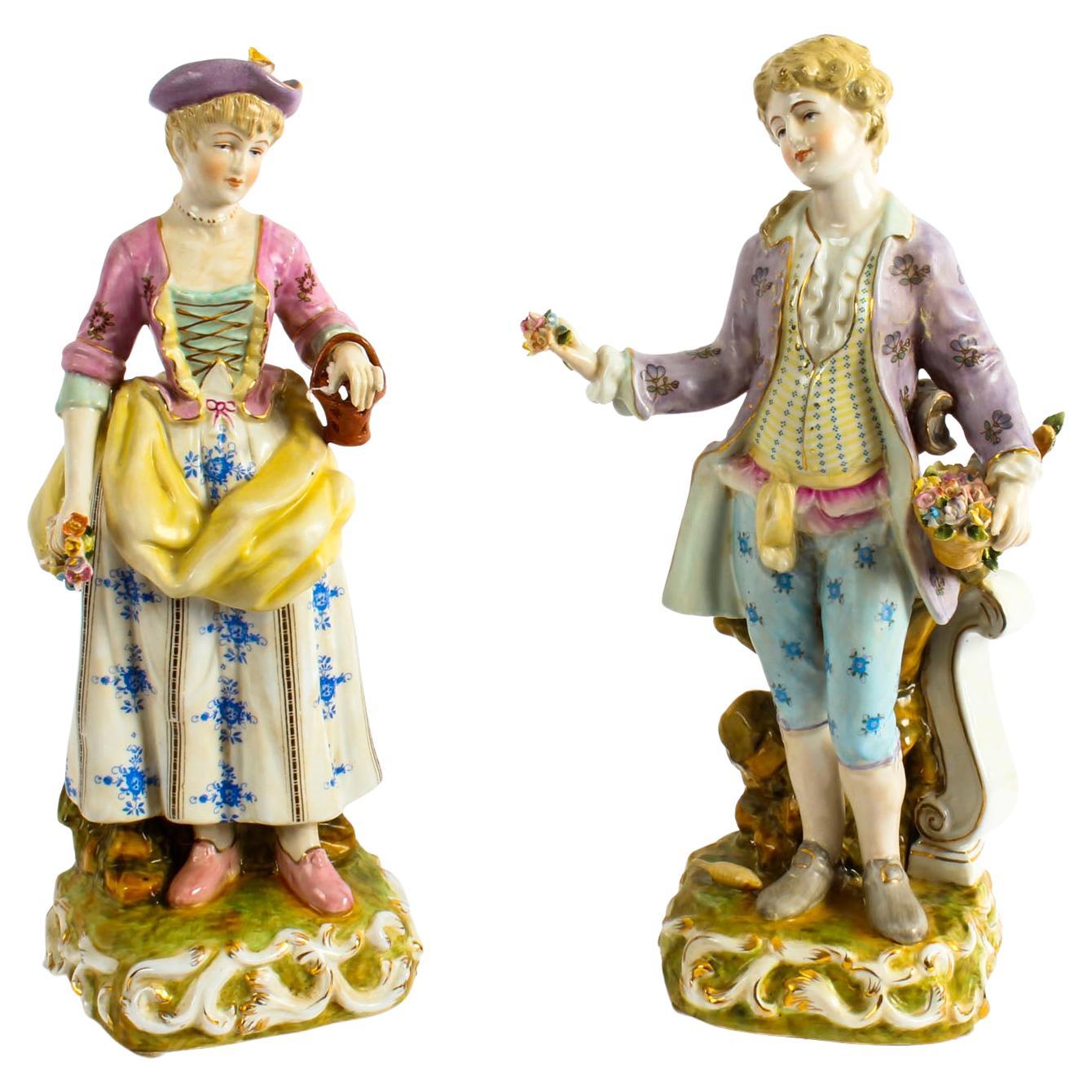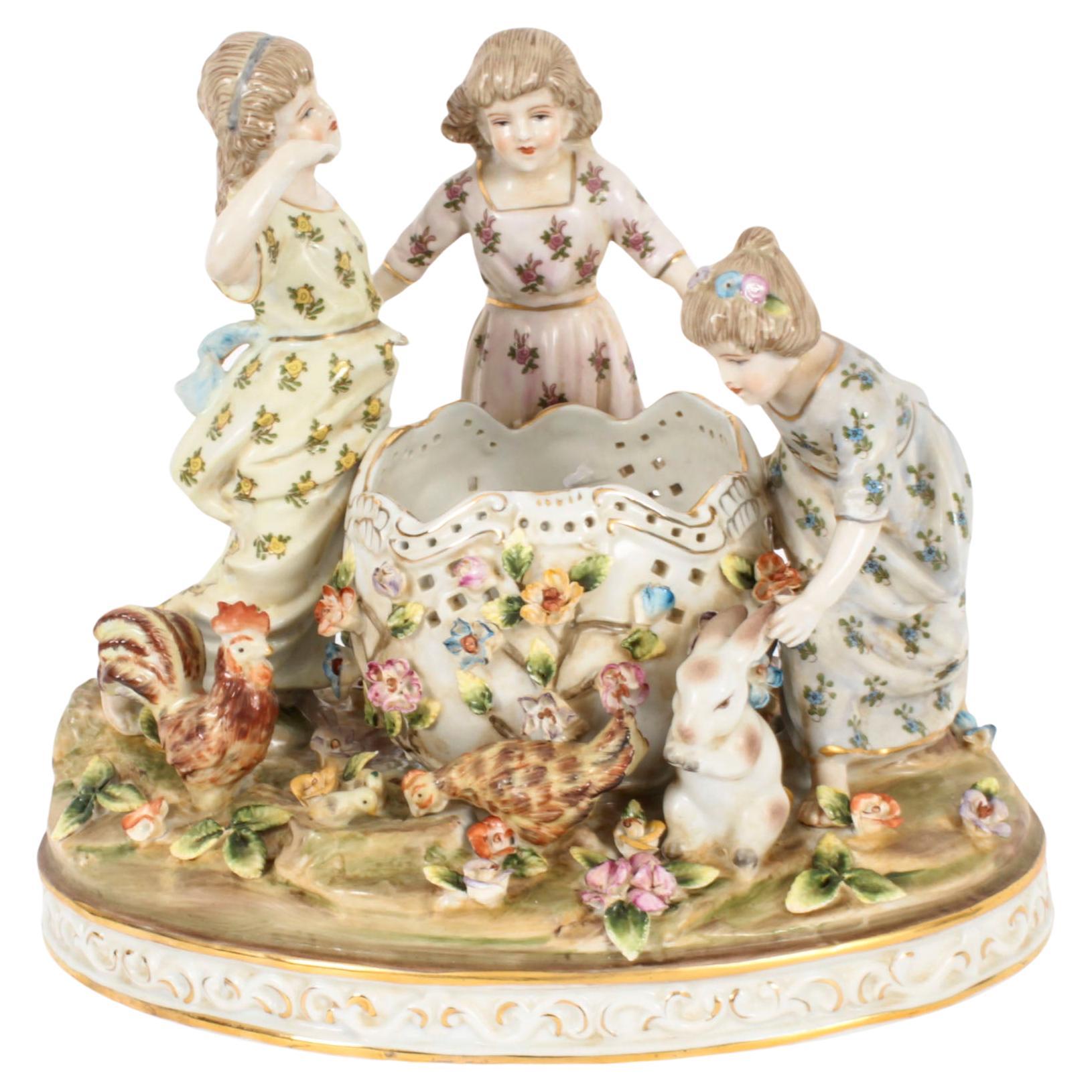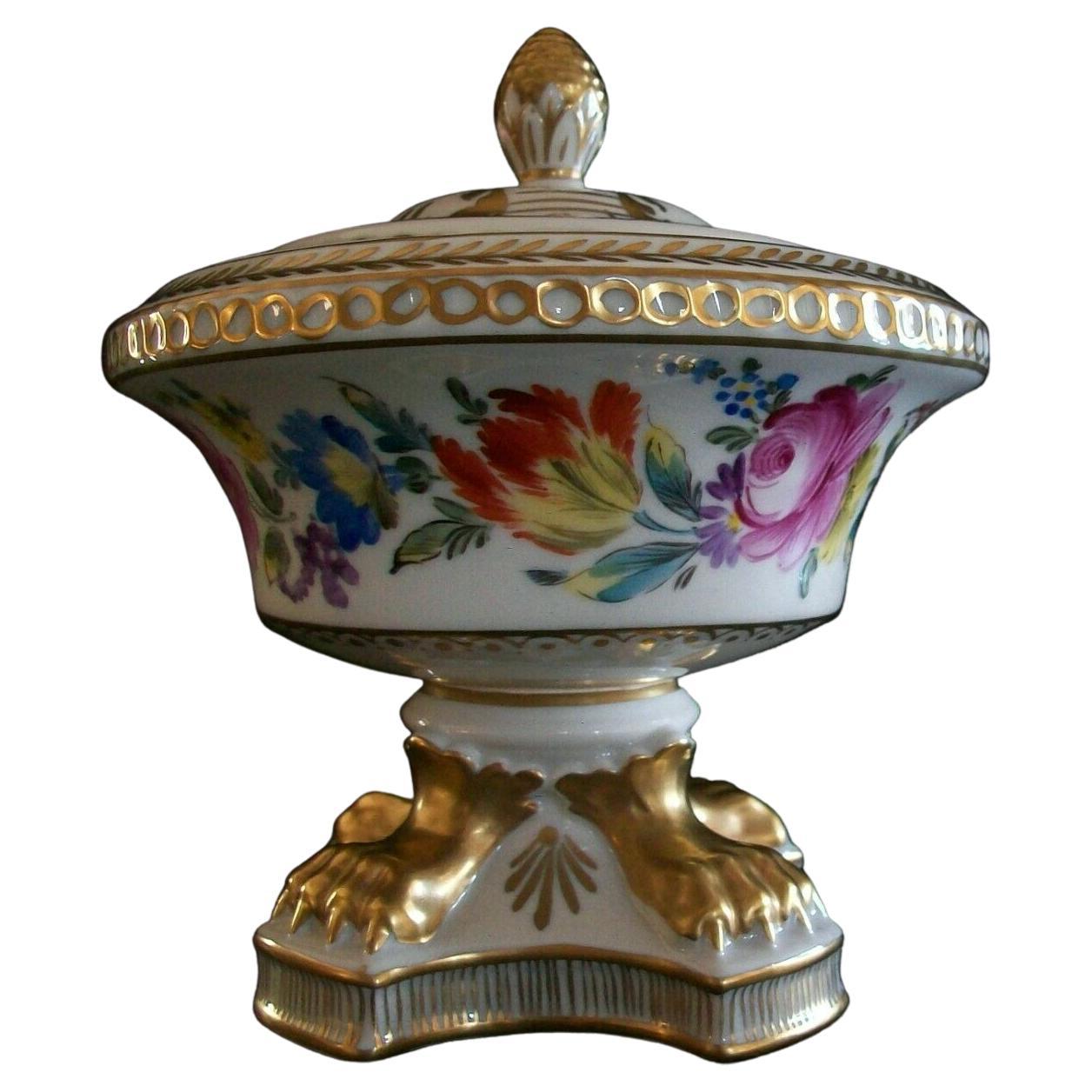Items Similar to Vintage Dresden Style Porcelain Centre Piece 20th Century
Want more images or videos?
Request additional images or videos from the seller
1 of 14
Vintage Dresden Style Porcelain Centre Piece 20th Century
About the Item
This is a beautiful and ornate Vintage Dresden Revival porcelain centrepiece, late 20th century in date.
The centrepiece features a winged cherub on each side holding an oval pierced basket-like dish with hand painted roses and foliate decoration in high relief.
There is no mistaking it's quality and unique design, which is certain to make it a treasured addition to your table.
Condition:
In excellent condition with no chips, cracks or signs of repair, and only minor signs of wear comensurate with age and use, please see photos for confirmation of condition.
Dimensions in cm:
Height 16 cm x Width 33 cm x Depth 17 cm
Dimensions in inches:
Height 6 inches x Width 1 foot, 1 inch x Depth 7 inches
Dresden porcelain - A King's Obsession
In the early 1700s, King Augustus II, prince elector of Saxony, held goldsmith Johann Bottger prisoner and commissioned him to create gold. Bottger instead discovered the method of creating porcelain, a favored and valuable item in the king's eyes.
The king announced to Europe in 1710 that he would open a porcelain manufactory in Dresden. He instead opened one at nearby Albrechtsburg castle in Meissen. Espionage was rampant, and the king guarded his porcelain secret, even though it meant imprisoning workers within the castle walls.
By 1720, the secret was leaked and porcelain producers popped up in Vienna and Venice. Dresden porcelain adopted Saxon crossed swords in under-glaze blue as its distinguishing mark.
In 1736, the porcelain manufactory produced the "Swan Service." It consists of 1,400 pieces, and is the largest, most lavish porcelain service ever created.
In 1872, Dresden built its own manufactory to better establish its role in porcelain production. The porcelain created in Dresden bears a blue crown marker to distinguish it from pieces made in Meissen.
Our reference: A3880
- Dimensions:Height: 6.3 in (16 cm)Width: 13 in (33 cm)Depth: 6.7 in (17 cm)
- Materials and Techniques:
- Place of Origin:
- Period:1990-1999
- Date of Manufacture:circa 1990
- Condition:
- Seller Location:London, GB
- Reference Number:
About the Seller
5.0
Platinum Seller
These expertly vetted sellers are 1stDibs' most experienced sellers and are rated highest by our customers.
Established in 1983
1stDibs seller since 2012
1,203 sales on 1stDibs
Typical response time: <1 hour
Associations
LAPADA - The Association of Arts & Antiques Dealers
- ShippingRetrieving quote...Ships From: London, United Kingdom
- Return PolicyA return for this item may be initiated within 14 days of delivery.
More From This SellerView All
- Vintage Pair of Delightful Dresden Style Porcelain Spill Vases 20th CenturyLocated in London, GBThis is a truly magnificent pair of hand painted porcelain spill vases accomplished in the Dresden manner, dating from the second half of the 20th century. Each vase features a maid...Category
Vintage 1980s German Porcelain
MaterialsPorcelain
- Pair Dresden Style Hand Painted Porcelain Figures Late 20th CenturyLocated in London, GBThis is a wonderful pair of hand painted porcelain figures in the Dresden style, dating from the last quarter of the 20th century. This delightful pair features a woman and a man standing tall in grace, adorned in classical garb and holding a basket of lovely flowers at their hands. They are depicted with absolutely fantastic attention to detail. These figures are a perfect addition to your existing collection or a good set to start your own porcelain collection. Condition: In excellent condition, please see photos for confirmation of condition. Dimensions in cm: Height 37 x Width 19 x Depth 15 Dimensions in inches: Height 1 foot, 3 inches x Width 7 inches x Depth 6 inches Dresden Porcelain - A King's Obsession In the early 1700s, King Augustus II, prince elector of Saxony, held goldsmith Johann Bottger prisoner and commissioned him to create gold. Bottger instead discovered the method of creating porcelain, a favored and valuable item in the king's eyes. The king announced to Europe in 1710 that he would open a porcelain manufactory in Dresden. He instead opened one at nearby Albrechtsburg castle. Espionage was rampant, and the king guarded his porcelain secret, even though it meant imprisoning workers within the castle walls. By 1720, the secret was leaked and porcelain producers popped up in Vienna and Venice. Dresden Porcelain adopted Saxon crossed swords in under-glaze blue as its distinguishing mark. In 1736, the porcelain manufactory produced the "Swan Service...Category
Vintage 1980s Porcelain
MaterialsPorcelain
- Vintage Dresden Revival Porcelain Centrepiece 'Children at Play' 20th CenturyLocated in London, GBThis is truly delightful Vintage classical porcelain centrepiece in the Dresden manner, dating from the last quarter of the 20th century. This stunning centrepiece is hand-painted w...Category
1990s German Porcelain
MaterialsPorcelain
- Antique Pair Dresden Lidded Porcelain Vases & Covers Early 20th CenturyLocated in London, GBThis is a beautiful pair of Dresden lidded vases and covers, circa 1900 in date. Superbly painted with panels of figural scenes of courting couples and flowers on a yellow and gilt ground, with underglaze blue Dresden marks to the bases. They are beautiful objects which will look fabulous in most surroundings. Condition: In excellent condition with no chips, cracks or signs of repair, and only very minor signs of wear comensurate with age and use, please see photos for confirmation of condition. Dimensions in cm: Height 32 x Width 20 x Depth 20 Dimensions in inches: Height 1 foot, 1 inch x Width 8 inches x Depth 8 inches Dresden porcelain - A King's Obsession In the early 1700s, King Augustus II, prince elector of Saxony, held goldsmith Johann Bottger prisoner and commissioned him to create gold. Bottger instead discovered the method of creating porcelain, a favored and valuable item in the king's eyes. The king announced to Europe in 1710 that he would open a porcelain manufactory in Dresden. He instead opened one at nearby Albrechtsburg castle. Espionage was rampant, and the king guarded his porcelain secret, even though it meant imprisoning workers within the castle walls. By 1720, the secret was leaked and porcelain producers popped up in Vienna and Venice. Dresden porcelain adopted Saxon crossed swords in under-glaze blue as its distinguishing mark. In 1736, the porcelain manufactory produced the "Swan Service...Category
Antique Early 1900s German Porcelain
MaterialsPorcelain
- Antique Pair Dresden Porcelain Pot Pourri Lidded Vases 1920s 20th CLocated in London, GBThis is a beautiful antique pair of fine quality Dresden porcelain pot pourri urns and covers, circa 1920 in date. Each painted with harbour scenes on a patterned ground and bearing underglaze blue AR marks. They are beautiful objects which will look fabulous in all surroundings. Condition: In really excellent condition with no chips, cracks or signs of repair, and only very minor signs of wear comensurate with age and use, please see photos for confirmation of condition. Dimensions in cm: Height 41 x Width 23 x Depth 17 Dimensions in inches: Height 1 foot, 4 inches x Width 9 inches x Depth 7 inches Dresden porcelain - A King's Obsession In the early 1700s, King Augustus II, prince elector of Saxony, held goldsmith Johann Bottger prisoner and commissioned him to create gold. Bottger instead discovered the method of creating porcelain, a favored and valuable item in the king's eyes. The king announced to Europe in 1710 that he would open a porcelain manufactory in Dresden. He instead opened one at nearby Albrechtsburg castle. Espionage was rampant, and the king guarded his porcelain secret, even though it meant imprisoning workers within the castle walls. By 1720, the secret was leaked and porcelain producers popped up in Vienna and Venice. Dresden porcelain adopted Saxon crossed swords in under-glaze blue as its distinguishing mark. In 1736, the porcelain manufactory produced the "Swan Service...Category
Vintage 1920s Porcelain
MaterialsPorcelain
- Vintage Italian Porcelain Charger Mid 20th CenturyLocated in London, GBThis is a beautiful huge vintage Italian porcelain charger, Circa 1950 in date. This colourful and decorative scene depicts a group of mai...Category
Vintage 1950s Italian Porcelain
MaterialsPorcelain, Hardwood
You May Also Like
- Carl Thieme, Dresden Floral Painted & Gilded Porcelain Urn, Germany, 20th CBy Carl ThiemeLocated in Chatham, ONCARL THIEME (Factory / Manufacturer) - Potschappel (Village / Location) - Empire style Dresden floral decorated and gilded porcelain urn with cover - ...Category
Mid-20th Century German Empire Urns
MaterialsEnamel, Gold Leaf
- Meissen Porcelain Leopard, 20th CenturyBy Meissen PorcelainLocated in Brighton, SussexA charming Meissen porcelain model of a seated Leopard on a white base, signed with the Meissen Blue crossed swords to the base. Batch 71 61587 DSKZN.Category
Vintage 1980s German Porcelain
MaterialsPorcelain
- 20th century French Louis XVI style Porcelain Coffee ServiceLocated in LEGNY, FRVery beautiful Louis XVI style coffee service dating from the 1930s in porcelain in very good condition consisting of: - A coffe jug - Two milk jugs - A sugar bowl - 16 coffee cups ...Category
Vintage 1930s French Louis XVI Porcelain
MaterialsPorcelain
- Porcelain Sample Plate, Early 20th CenturyBy Haviland & Co.Located in Spencertown, NYTheodore Haviland, Limoges, France Painted with various hand-enameled color references and numbers over-glaze beneath color tabs. Marked to the front in orange-yellow enamel: "Coule...Category
Early 20th Century French Industrial Decorative Dishes and Vide-Poche
MaterialsPorcelain
- Mother with Children, Porcelain, 20th CenturyLocated in Madrid, ESEnameled porcelain figure inspired by 18th century works of outstanding manufactures such as Sèvres, showing a lady sitting in an sofa and accompanied by a girl and a younger child. ...Category
20th Century European Other Porcelain
MaterialsPorcelain
- Minton Porcelain Centre Piece, Mazarine Blue with Gilt, Sèvres Style, 1862-1870By MintonLocated in London, GBOn offer is a sublime and very rare centre piece made by Minton between 1862 and 1870, which was the Victorian era. The centre piece is made in the Sèvres style and decorated in a mazarine or cobalt blue ground with rich and very fine gilding. The piece is probably made as a potpourri. This piece would make a fabulous display on your Easter, Thanksgiving or Christmas table! Minton was one of the pioneers of English china production alongside other great potters such as Spode, Davenport, Ridgway, Coalport and others. They were located in Staffordshire and were known specifically for their wonderfully fine white bone china and bright colours; there is a colour called "Minton Blue" which is a fresh azure blue that was very fashionable during the Victorian era. Throughout the different phases of its existence, the factory made top quality creamware, porcelain, majolica and ultimately the finest parian porcelain. Minton excelled in their decorations and gilt work; these were often executed by artists who came from the Sèvres factory in France and brought their skills with them. This large centre piece consists of three pieces: the base, the actual comport that can hold a liberal amount of food such as a large piece of game, and the cover. That being so, these pieces are more known for their decorative value and make a stunning display at the centre of a table setting. This piece is not documented and no pictures are known of it other than one I have heard about in the grapevine but never seen myself: an image in a collection of images of the designs made by Minton for Thomas Goode, the famous retailer in London. The relationship between Minton and Thomas Goode was a long and fruitful one. Goode, who was a close friend of Herbert Minton, commissioned a series of Victorian ornamental pieces in imitation of the late 18th Century Sèvres pieces that Goode had in his own collection. Minton did not just copy the Sèvres pieces, but created entirely new ones using the old 18th Century designs, hereby moving decidedly away from the English Rococo style, which had become increasingly strange and a little tired over the years. Minton, who had taken on Léon Arnoux, previously a painter at Sèvres, as Art Director. Arnoux was able to revive the design of ornamental wares in English soft paste porcelain...Category
Antique 1860s English Victorian Urns
MaterialsPorcelain





